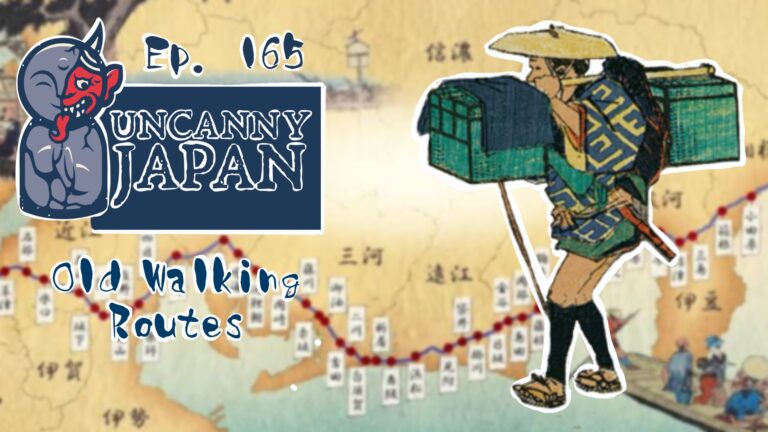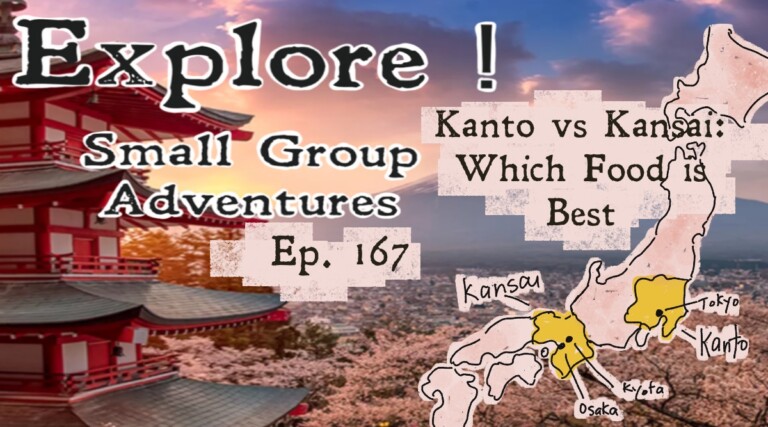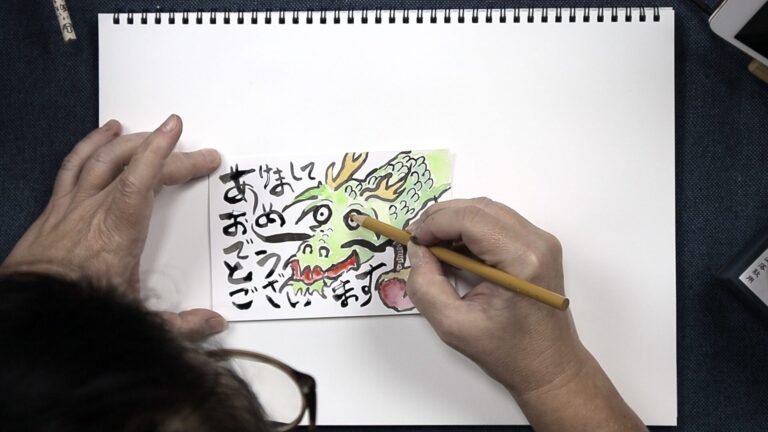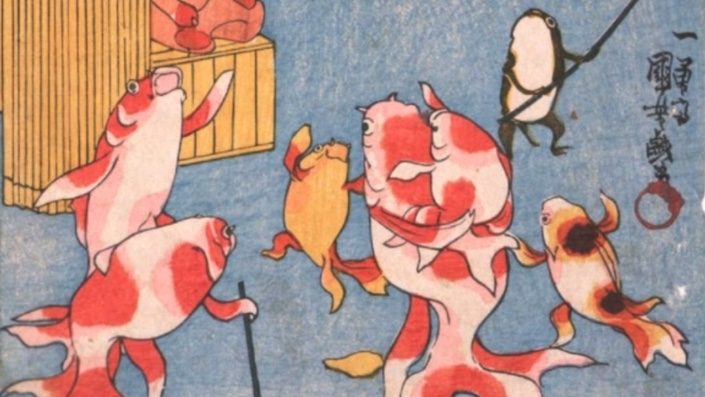I’m author Thersa Matsuura and I’m here to share with you all those hidden, fascinating, and sometimes frightening corners of old Japan. Join me as I explore strange superstitions, curious creatures, and cultural enigmas right here on Uncanny Japan.
Japan’s Hidden Fifth Season
Don’t let anyone tell you that Japan has four distinct seasons. You’ll hear that a lot, but it’s not true. Japan actually has five seasons. Everyone forgets tsuyu, the rainy season, and all that entails. Unless you’re talking about Hokkaido, the northernmost island, they don’t have a rainy season there, so in that case, your friend isn’t lying to you. There are four seasons. Today, let’s curl up with the sound of spring rain that we recorded early one morning on my veranda. You’ll hear the very first frogs of the year, a handful of birds, and a crow vying for attention. And while relaxing to the sounds, let’s also learn about all things rain.
Understanding Tsuyu – The Plum Rain Season
It’s called rainy season in English and tsuyu or bayu in Japanese. Tsuyu and bayu are different pronunciations for the same two characters, plum rain. Beautifully named because this is the time of year the plums ripen, which I’m excited about, by the way, because I found some wild plum trees near my house. While out participating in our annual river cleaning, or more precisely, providing moral support to Richard who was doing the actual work of shoveling mud, our neighborhood leader and I started chatting. He urged me to come pick the plums once they were ready for making plum wine or umeboshi, pickled plums. I asked several times, “Are you sure?” and he said, “Yes, of course.” So that’s my next project.
Okay, the rainy season. So nice, you gotta name it more than twice. You’ve got tsuyu and bayu. And there’s also samidare, literally “may rain.” Where tsuyu is an umbrella term for the entire rainy season, samidare refers more to the nature of the rain, intermittent and gentle. It has a much nicer and poetic feel to it than tsuyu. If you’re writing haiku, use samidare. So what’s there to know about tsuyu?
The Dreaded Reality of Rainy Season
Well, it’s arguably the most dreaded and miserable time in Japan. Basically, one day you’re out kicked back under a bunch of cherry trees, sipping 7-Eleven wine out of a can with your friends, enjoying the otherworldly enchantment of being showered by thousands of delicate pink petals. And the next day, you wake up to gray skies and drizzle. All day. All night. Day after day. Some days more rain, constant, relentless. Some days less. Occasionally, if you’re lucky, you’ll get no rain for a couple days, but it’s still pretty much overcast with a low, gray sky. “But I love rain,” you say.
Well, I do too, but this isn’t like the thrill of having a refreshing spring shower or a good, vigorous thunderstorm sweep in and shake things up. It’s very low-key and monotonous. It also starts getting progressively warmer and more humid as the days drag on. That bread you bought at the store? Don’t leave it out for even one day. Mold. Your shower tiles that you just spent an hour scrubbing? Give them a day or two. Mold. Everything molds. I’ve lost leather shoes, handbags, and jackets because I didn’t take proper precautions during Tsuyu. If you’re not careful, you’ll get mold growing in the corners of your room, on your books. Window frames are notorious for it. Even tatami mats.
Traditional Architecture Against the Humidity
See? Now it makes sense why traditional Japanese houses are built less sturdy and not a shred of insulation, but they are more easily air-adable. Yes, there are other reasons for the way they’re constructed, but some things do make sense. They’re often raised off the ground for air to circulate under the house. The rooms are separated by shoji or fusuma doors, which can be lifted off their tracks to allow for better air circulation. Shoji doors are made with washi paper, which is porous and it allows for moisture to transfer, preventing stagnant, humid air to accumulate all in one place.
You’ll also find lamma, or transom windows between rooms in old houses. These are the spaces between the ceiling and the lintel of the fusuma door. Instead of being completely open, they are carved wooden panels. Sometimes extremely intricate scenes of trees and bridges, temples and clouds. There are lattice bamboo ones which are pretty too. Next time you’re in a traditional Japanese home or temple, look up. The nicer place you’re in, the more gorgeous they are. And now you know, they’re not just there because of their beautiful artistic value. They also provide the movement of air and light too.
Mold. The word bayu, using not plum but a different kanji for “bai,” translates as “mold rain.” It’s not common, but I’ve seen it used.
So for travelers, just so you know, the rainy season varies, but in general it’s from June through mid-July. Of course, rolling over Okinawa a month or so earlier. This year, the newscasters are all up in arms that the rainy season is two weeks early down south. Wherever you are, you’ll know it’s upon you when you listen to the news and they have the new bai reports. Yes, special weather reports showing where the rainy season has officially started. Then a month or so later, everyone will look forward to the official end, called tsuyu-ake.
Ironically, there are some years called kara-tsuyu, or dry rainy season, which means very little or almost no rain. And almost always, the official start and stop dates never match up with exactly how the weather is behaving. So everyone always comments on that.
Rain Superstitions and Weather Signs
A couple rain superstitions that I’ve found to be true. If you see a cat washing its face, it’s going to rain. Neko ga kao wo arau to ame. That has something to do about air pressure or damp whiskers. Another one is, tsubame ga hikuku tobu to ame. When you see swallows flying around low, it’s going to rain. This one refers to how bugs fly low before rain, being damp or something, and since swallows eat bugs, they have to zip around lower to catch them.
Yokai and Spirits of the Rainy Season
Now who might you meet on a drizzly gray spring day in Japan? Let’s start with the most obvious, the amefurikozo, a strange-looking little yokai who wears an old fashion umbrella on its head and creeps around on rainy days. He was first introduced by Toriyama Sekien in his Konjaku Gazu Zoku Hyakki. But this little rainfall boy quickly became popular, much like the tofukozo, the creepy little dude who carries a small plate of tofu around and offers it to you. And during the Edo era, you could find both of them everywhere, books, toys, games, and karuta, cards.
You hear stories of the amefurikozo actually making it rain or just being there when it happens. In more modern versions of his stories, you have almost an urban legend feel with things like, if you take the umbrella from him and you put it on your own head, you’ll never be able to remove it. Or if you talk to him, you’ll get covered in blue mold. Mold again.
Next, there’s a newish yokai called Tsuyukyubi, or rainy season nine tails. It comes from the game Yokai Watch. Tsuyukyubi is a nine-tailed green fox wearing a cute hooded frog cape. It controls the rain by collecting the mysterious power of all that tsuyu drizzle. It will make it rain heavily, but then after it stops, there appears a beautiful rainbow. Just a side note, rainbows don’t ever appear during the rainy season.
Another rainy day or night creature is the ame-onna. This yokai too was first brought to the forefront in the 1700s when Toriyama Sekien carved an image of a ghostly long-haired woman standing by a lantern in the rain and licking her hand. One legend of this ame-onna says that any mother who has lost a child on a rainy day because a tengu flew in and stole it away, kamikakushi, would turn into an ame-onna. She would then appear in front of crying children on those sodden days carrying a large sack, presumably to steal them away. My guess would be she’s looking for her own lost child. But there are other tales of how the ame-onna can both bring rain to make your days miserable or to break a drought.
There’s another very interesting kind of ame-onna. Way back in my first year or two in Japan, I remember going out with a friend somewhere and it rained. My friend apologized and said it was her fault. She was an ame-onna, or rain girl. I had no idea what this meant. But she explained that if someone goes out or has some special event planned like a picnic or sports meet or even a big test, and invariably it rains, they are an ame-onna, rain girl, or ame-otoko, rain boy.
I thought this was charming, that people in Japan pay attention to the weather and sudden changes on important days, and when they are looking forward to something, like they somehow control the weather. While being an ame-onna or ame-otoko seems like a negative thing, and it kind of is, on the flip side, it’s said that the ame-onna and the ame-otoko have good memories and that the dragon god, we talked about before, Ryujin, loves them. So you’ve got that going for you.
The opposite, which is also common, is the hare-otoko or hare-onna. When these two go anywhere, the sun shines. Even if the weather looks iffy the day before, they show up and it’s blue skies and sunshine. I mostly hear people using the phrase when talking about themselves. “I hope the weather is fine for our camp next week. I’m an ame-otoko.” Or, “Don’t worry about the barbecue. I’m a hare-onna.”
Speaking of rain, there are all sorts of legends and old wives tales about something called an amatsubo or rainpot. In Shimane prefecture, there’s a nanafushigi, seven mysterious things, about an amatsubo that is basically a curious formation of rocks. It’s not very big. It’s on the ground and it’s kind of indented like a bowl or a pot. It’s called the rainpot and it’s said that if anyone does anything to disturb it, it will anger the god, Susanoo, the god of storms and sea, and cause a great flood.
There’s even a story of a man who did push his luck and messed with this particular amatsubo. The next day, a storm hit the village and caused a great flood. The man who disobeyed the legend and incurred Susanoo’s wrath was thusly expelled from the village.
Finding Beauty in the Gloom
There are some nice things about the rainy season, rice fields being planted, and the awakening of a gazillion frogs to name two. There’s also ajisai or hydrangea. These beloved flowers thrive in the tsuyu season. There are over a hundred different kinds in all shades of blues and pinks and purples. Some temples and shrines are known for them and you can find ajisai festivals celebrating them too.
Now, ajisai are a little poisonous, so whatever you do, don’t do this, but there is a variety or two from which a special tea is brewed. It’s called amacha, or sweet tea, or amagi amacha. There’s no caffeine, it’s quite sweet due to a natural sweetener that is up to 200 times sweeter than sucrose. It’s quite the process to make the tea and even the Japanese Ministry of Health recommends not to exceed three grams of amacha per liter of water.
But one special thing it’s used for is the hanamatsuri, or flower festival, that celebrates the birth of the Buddha. This takes place every year on April 8th. In this ceremony, there’s a flower room where all kinds of flowers are arranged along with a small statue of the Buddha, usually placed in a large bowl. The statue is washed with the sweet hydrangea tea, and by washing I mean you use a bamboo spoon or ladle to pour three spoonfuls over the statue. The amacha is symbolic of the pure water dragons used after the Buddha was born to cleanse him.
So that’s pretty much all things rainy season. It’s not the best time to travel in Japan, but there is definitely beauty to be found in misty temples, moss-covered stones, and dark, lush forests. I think it’s pretty clever though. You’ve got this oppressive, somewhat dismal month or so, really makes you look forward to summer. One day it’s dark and gloomy outside, and the next the sky opens up to bright blue and fat, pillowy white clouds. You’re briefly excited, and then the temperature starts hitting 40 degrees Celsius or over 100 Fahrenheit, and you recall central air conditioning isn’t a thing, which drums up a whole new set of woes.
But at least in summer you’ve got kakigori, shaved ice, obon festivals, fireworks, and ghost stories to try to keep you cool. Let’s end with some beautiful poetic words about the rainy season.
Samidari ya namida no iro no ajisai ni. Early summer rain, the color of tears, on the hydrangea.
Thank you for listening. Everyone stay safe and well. Consider becoming a patron if you’re able and would like to support the show and get some extra content. I will talk to you all in two weeks. Bye-bye.






